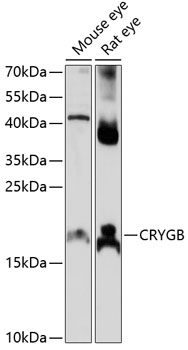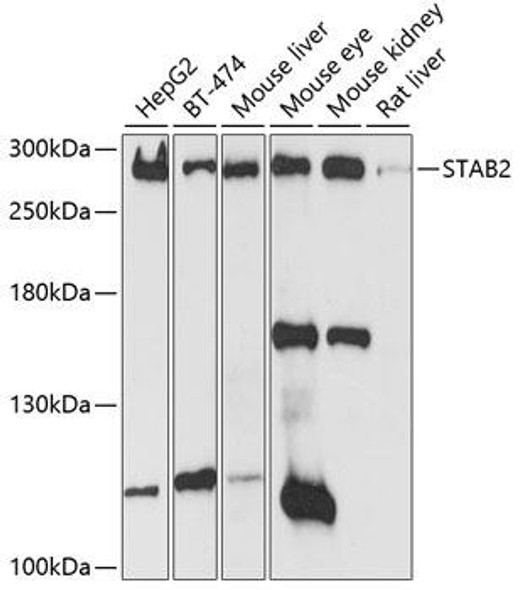Anti-CRYGB Antibody (CAB14569)
- SKU:
- CAB14569
- Product type:
- Antibody
- Reactivity:
- Mouse
- Rat
- Host Species:
- Rabbit
- Isotype:
- IgG
- Antibody Type:
- Polyclonal Antibody
- Research Area:
- Cell Biology
Frequently bought together:
Description
| Antibody Name: | Anti-CRYGB Antibody |
| Antibody SKU: | CAB14569 |
| Antibody Size: | 20uL, 50uL, 100uL |
| Application: | WB |
| Reactivity: | Mouse, Rat |
| Host Species: | Rabbit |
| Immunogen: | Recombinant fusion protein containing a sequence corresponding to amino acids 80-135 of human CRYGB (NP_005201.2). |
| Application: | WB |
| Recommended Dilution: | WB 1:500 - 1:2000 |
| Reactivity: | Mouse, Rat |
| Positive Samples: | Mouse eye, Rat eye |
| Immunogen: | Recombinant fusion protein containing a sequence corresponding to amino acids 80-135 of human CRYGB (NP_005201.2). |
| Purification Method: | Affinity purification |
| Storage Buffer: | Store at -20°C. Avoid freeze / thaw cycles. Buffer: PBS with 0.02% sodium azide, 50% glycerol, pH7.3. |
| Isotype: | IgG |
| Sequence: | CLIP PHSG AYRM KIYD RDEL RGQM SELT DDCI SVQD RFHL TEIH SLNV LEGS WILY |
| Gene ID: | 1419 |
| Uniprot: | P07316 |
| Cellular Location: | |
| Calculated MW: | 20kDa |
| Observed MW: | 21kDa |
| Synonyms: | CRYGB, CRYG2, CTRCT39 |
| Background: | Crystallins are separated into two classes: taxon-specific, or enzyme, and ubiquitous. The latter class constitutes the major proteins of vertebrate eye lens and maintains the transparency and refractive index of the lens. Since lens central fiber cells lose their nuclei during development, these crystallins are made and then retained throughout life, making them extremely stable proteins. Mammalian lens crystallins are divided into alpha, beta, and gamma families; beta and gamma crystallins are also considered as a superfamily. Alpha and beta families are further divided into acidic and basic groups. Seven protein regions exist in crystallins: four homologous motifs, a connecting peptide, and N- and C-terminal extensions. Gamma-crystallins are a homogeneous group of highly symmetrical, monomeric proteins typically lacking connecting peptides and terminal extensions. They are differentially regulated after early development. Four gamma-crystallin genes (gamma-A through gamma-D) and three pseudogenes (gamma-E, gamma-F, gamma-G) are tandemly organized in a genomic segment as a gene cluster. Whether due to aging or mutations in specific genes, gamma-crystallins have been involved in cataract formation. |
| UniProt Protein Function: | CRYGB: a major structural protein of the eye lens. A member of the beta/gamma-crystallin family. Gamma-crystallins are a homogeneous group of highly symmetrical, monomeric proteins typically lacking connecting peptides and terminal extensions. Gamma-crystallins are involved in cataract formation. |
| UniProt Protein Details: | Protein type:Cytoskeletal Chromosomal Location of Human Ortholog: 2q34 Disease: Cataract 39, Multiple Types |
| NCBI Summary: | Crystallins are separated into two classes: taxon-specific, or enzyme, and ubiquitous. The latter class constitutes the major proteins of vertebrate eye lens and maintains the transparency and refractive index of the lens. Since lens central fiber cells lose their nuclei during development, these crystallins are made and then retained throughout life, making them extremely stable proteins. Mammalian lens crystallins are divided into alpha, beta, and gamma families; beta and gamma crystallins are also considered as a superfamily. Alpha and beta families are further divided into acidic and basic groups. Seven protein regions exist in crystallins: four homologous motifs, a connecting peptide, and N- and C-terminal extensions. Gamma-crystallins are a homogeneous group of highly symmetrical, monomeric proteins typically lacking connecting peptides and terminal extensions. They are differentially regulated after early development. Four gamma-crystallin genes (gamma-A through gamma-D) and three pseudogenes (gamma-E, gamma-F, gamma-G) are tandemly organized in a genomic segment as a gene cluster. Whether due to aging or mutations in specific genes, gamma-crystallins have been involved in cataract formation. [provided by RefSeq, Jul 2008] |
| UniProt Code: | P07316 |
| NCBI GenInfo Identifier: | 311033463 |
| NCBI Gene ID: | 1419 |
| NCBI Accession: | P07316.3 |
| UniProt Secondary Accession: | P07316,Q17RB5, Q53ST2, |
| UniProt Related Accession: | P07316 |
| Molecular Weight: | 20,908 Da |
| NCBI Full Name: | Gamma-crystallin B |
| NCBI Synonym Full Names: | crystallin gamma B |
| NCBI Official Symbol: | CRYGB |
| NCBI Official Synonym Symbols: | CRYG2; CTRCT39 |
| NCBI Protein Information: | gamma-crystallin B |
| UniProt Protein Name: | Gamma-crystallin B |
| UniProt Synonym Protein Names: | Gamma-B-crystallin; Gamma-crystallin 1-2 |
| Protein Family: | Gamma-crystallin |
| UniProt Gene Name: | CRYGB |
| UniProt Entry Name: | CRGB_HUMAN |









